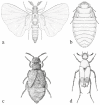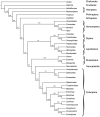Strepsiptera, phylogenomics and the long branch attraction problem
- PMID: 25272037
- PMCID: PMC4182670
- DOI: 10.1371/journal.pone.0107709
Strepsiptera, phylogenomics and the long branch attraction problem
Abstract
Insect phylogeny has recently been the focus of renewed interest as advances in sequencing techniques make it possible to rapidly generate large amounts of genomic or transcriptomic data for a species of interest. However, large numbers of markers are not sufficient to guarantee accurate phylogenetic reconstruction, and the choice of the model of sequence evolution as well as adequate taxonomic sampling are as important for phylogenomic studies as they are for single-gene phylogenies. Recently, the sequence of the genome of a strepsipteran has been published and used to place Strepsiptera as sister group to Coleoptera. However, this conclusion relied on a data set that did not include representatives of Neuropterida or of coleopteran lineages formerly proposed to be related to Strepsiptera. Furthermore, it did not use models that are robust against the long branch attraction artifact. Here we have sequenced the transcriptomes of seven key species to complete a data set comprising 36 species to study the higher level phylogeny of insects, with a particular focus on Neuropteroidea (Coleoptera, Strepsiptera, Neuropterida), especially on coleopteran taxa considered as potential close relatives of Strepsiptera. Using models robust against the long branch attraction artifact we find a highly resolved phylogeny that confirms the position of Strepsiptera as a sister group to Coleoptera, rather than as an internal clade of Coleoptera, and sheds new light onto the phylogeny of Neuropteroidea.
Conflict of interest statement
Figures



References
-
- Huelsenbeck JP, Hillis DM (1993) Success of phylogenetic methods in the four-taxon case. Systematic Biology 42: 247–264.
-
- Huelsenbeck JP (1995) The robustness of two phylogenetic methods: four-taxon simulations reveal a slight superiority of maximum likelihood over neighbor joining. Molecular biology and evolution 12: 843–9. - PubMed
-
- Graybeal A (1994) Evaluating the phylogenetic utility of genes: A search for genes informative about deep divergences among vertebrates. Systematic Biology 43: 174–193.
-
- Wong KM, Suchard MA, Huelsenbeck JP (2008) Alignment uncertainty and genomic analysis. Science 319: 473–476. - PubMed
-
- Boussau B, Daubin V (2010) Genomes as documents of evolutionary history. Trends in ecology & evolution 25: 224–232. - PubMed
Publication types
MeSH terms
Substances
Associated data
Grants and funding
LinkOut - more resources
Full Text Sources
Other Literature Sources

